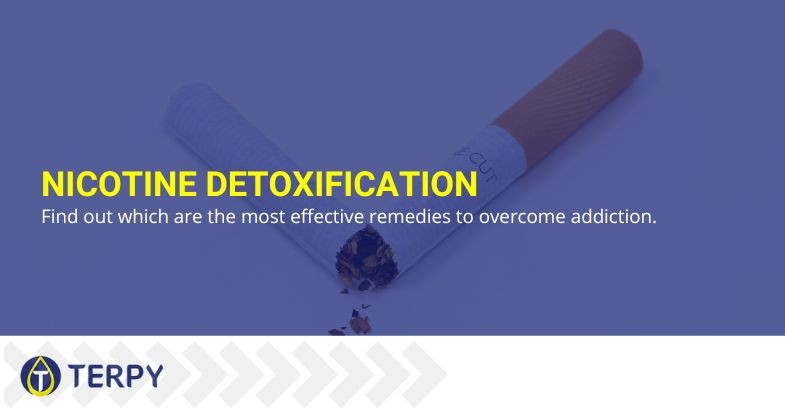Published on: 25/07/2022
Some useful information on nicotine withdrawal syndrome.
If you are reading this article, chances are you are considering quitting smoking or perhaps helping someone close to you to do so.
Nicotine withdrawal syndrome is an actual disease, recognised in its own right. For this reason, it is good not to underestimate the enormous effort required to take this step and help yourself and others to persevere in achieving the goal.
Nicotine withdrawal: what is it? And what are the symptoms?


Nicotine withdrawal is a prevalent condition experienced immediately after smoking your last cigarette. It presents itself with different states of mind due precisely to the lack of intake of nicotine, a component of tobacco that is highly addictive, on a par with other substances such as alcohol and cocaine, to name a few.
For all intents and purposes, nicotine withdrawal is considered an actual disease. It is mentioned in the WHO list of conditions and the Diagnostic and Statistical Manual of Mental Illness.
But what does it depend on?
The intake of this substance, especially when it is constant and long-lasting, causes a sort of habit in the human body, especially in the brain.
In fact, according to various studies, this syndrome depends precisely on the brain’s reaction of an ex-smoker who feels the lack of a substance now considered indispensable.
Being the result of a habit, with a bit of willpower and determination, it is possible to reverse the body’s tendency and gradually restore the state before tobacco addiction.
But how to tell if you are experiencing the symptoms of nicotine withdrawal syndrome?
The first sign is undoubtedly the uncontrollable urge to smoke. If you find yourself in this situation, try to resist. It will not last long.
Secondly, your body may manifest a whole series of symptoms, among which are
- nausea and intestinal cramps;
- headaches;
- anxiety;
- depression;
- marked irritability;
- constipation;
- drowsiness during the day and disturbed sleep at night;
- increased appetite;
- difficulty concentrating;
- feelings of frustration;
- tingling in the hands and feet.
In short, a long list and quite challenging to manage. The good news we will discuss later is that if you have the strength to resist, they will subside until they disappear in a short time.
Some expedients can help you overcome it.
Read also: Nicotine allergy: symptoms, reactions and remedies
What are the most effective remedies against nicotine withdrawal symptoms?
The first advice I want to give you is not to underestimate the power of programmes that teach you how to stop smoking. I know they may seem ineffective, but they contain many tricks and techniques that can be very helpful.
In case this kind of help is not enough, or the symptoms are too disabling for you to carry out your daily activities, there are additional aids you can turn to, such as nicotine substitutes.
In the form of inhalers, chewing gum or patches, these products are designed exclusively to support those who decide to quit smoking, helping to decrease nicotine intake and thus reduce withdrawal symptoms gradually.


For pregnant women, a preventive consultation with a doctor is essential, who will be able to assess the risks and possibly suggest alternatives.
In addition, you can put into practice some simple strategies to suffer less during this delicate phase:
- avoid the company of smokers, especially while they are smoking;
- avoid as much as you can the consumption of substances such as alcohol and caffeine – I remind you that it is also contained in tea – given their ability to provoke the body’s demand for nicotine;
- engage in physical activity or increase it if you already do so. Sport has the power to reduce stress, which is often one of the reasons why you feel like smoking;
- cultivate new hobbies and pastimes. They will serve to distract you in your free moments, which you used to take advantage of to light up a cigarette;
- always keep chewing gum handy. Even if these are not specific for quitting smoking, they will alleviate the urge considerably;
- talk to people who have already been through it. It will give you a chance not to think that it is an impossible feat and also may suggest new tactics you can use to achieve your goal;
- be patient. This is important because it may seem extremely difficult for you to resist. Keep in mind, however, that it is only a phase, and if you keep your determination, it will end sooner than you think.
Soon you will experience the benefits of quitting smoking and be happy personally.
Let’s see how your body reacts to the lack of nicotine and how quickly it stabilises.
What happens to your body when you quit smoking?
The first symptoms of nicotine withdrawal appear very early. Then, it only takes 2 to 3 hours after the last puff of smoke to feel the urge to smoke again.
After 3 days, your body will be wholly cleansed of nicotine in your bloodstream, and the acute withdrawal phase begins. After 3 days, you may desire to smoke more intensely and experience irritability and difficulty maintaining concentration.
This phase will begin to subside around 2-3 weeks after the last intake, finally allowing you to start feeling less tempted to start again.
Let us now look in more detail at what happens to the body of a person who has quit smoking overnight and without the support of nicotine substitutes.
- After a few hours
the effect of the last dose of nicotine taken wears off, and the urge to smoke appears. - After about ten hours
the subject is permeated by a feeling of restlessness and manifests an uncontrollable urge to smoke. He also has the perception of not knowing how to use time. - After 1 day:
the irritability increases and with it the feeling of hunger. - After 2 days:
the amount of nicotine in the bloodstream is almost zero, and the subject begins to experience headaches. - After 3 days:
at this point, the nicotine has wholly disappeared from the body, and the consequence on the subject is an increasing state of anxiety. - After 1 week:
the nicotine withdrawal syndrome is now in the acute phase. The subject experiences all associated symptoms and should avoid risky situations, such as frequenting places or people that may accentuate the urge to smoke. - After 2-4 weeks
the withdrawal symptoms finally begin to become less overbearing. In this phase, the subject experiences a lessening appetite, a decrease in anxiety, feels calmer and no longer has to fight as hard not to give in as he did in the previous phase. - After five weeks
the person is cured, the symptoms have disappeared completely, and from now on, not smoking will only be a matter of willpower.
In conclusion, detoxing from nicotine is not a walk in the park, but it is possible.
If you have decided to embark on the challenging path to freedom from smoking, you now have a straightforward overview of what lies ahead.
Be sure not to lose sight of the goal, and remember that even nicotine withdrawal syndrome cannot last forever?





